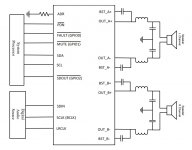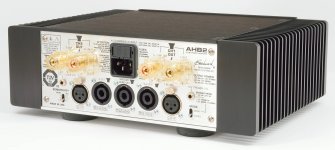So using a screw down post in the speakon than the speakon contact, (and sometimes another screw down on the speaker speakon) to pass a signal is better than just one screw down post on the speaker, eliminating one or two contacts? Speakons are great if its not a permanent conection, as in PA land. Better than banana plugs, otherwise unnecessary.
Actually the JC1+ power amp looks kind of shoddy, compared to its more expensive competition. We put most of our money and effort under the cover, so to speak.
Bruno's pruify amp is a 4 wire sensing amp, I seem to recall him talking about moving the sense point to the powercon conn as part of his attempt to lower distortion. In other words it ain't just the connector.
Cheers
Alan
Cheers
Alan
"Looks" is a huge part of pricing, in all kinds of products/services. Can y'all say "cars and trucks"?
I might be in a minority, but I couldn't care less about an audio product's looks. I'm much more interested in quality and performance.
I wouldn't call the JC1+ "shoddy-looking" by any means. It's just not "flashy", and that's fine with audio pros.
I might be in a minority, but I couldn't care less about an audio product's looks. I'm much more interested in quality and performance.
I wouldn't call the JC1+ "shoddy-looking" by any means. It's just not "flashy", and that's fine with audio pros.
Last edited:
And I say this as someone who powers his system off a pair of tpa3255 evm's.
You certainly have my setup beat regarding dynamic headroom! I'm running the paltry tas5825 with maybe 10X less power available to the speaker.
However the tas is digital input and I assume the way the board is designed, it receives an I2S stream directly from a bluetooth module. (it does have an analog input I assume provided as a convenience, so I wont bet my life on it; however by spec it's definitely a digital input amplifier)
The output works the same way as the 3255, a H bridge with each leg sitting at 50% duty quiescent. I assume the 5825 converts the input data sample word directly to a PWM value; (attached diagram)
So in using this kind of amplifier, I dont get to choose my own DAC; that happens within the amp itself...it is a DAC, albeit one that outputs +/- 25V and current at the ampere level. Hopefully I've conveyed my understanding right.
I see a couple of manufacturers making powered wireless stereo speaker sets with DSP. I assume they're going after any advantage of all digital signal path, no cables, a good initial driver/cabinet design made even better with DSP - and room corrections.
In the (near) future your speaker will probably host a webpage like your router does, where after set up - you promptly forget it. (I dont know which "channels" my G and N bands are operating on, off the top of my head) Or maybe instead of fooling with cables and dc blocking caps, you now fool with numbers in a webpage tab.
Attachments
I think the main advantage of the Speakon connector is that it’s pretty much foolproof in a studio or touring band/roady type environment in a way binding posts of any quality are not. So it gets my vote for that but I’d be a bit surprised to find it on the back of a high quality amp.
...I’d be a bit surprised to find it on the back of a high quality amp.
Surprise!
Attachments
You certainly have my setup beat regarding dynamic headroom! I'm running the paltry tas5825 with maybe 10X less power available to the speaker.
...
In the (near) future your speaker will probably host a webpage like your router does, where after set up - you promptly forget it. (I dont know which "channels" my G and N bands are operating on, off the top of my head) Or maybe instead of fooling with cables and dc blocking caps, you now fool with numbers in a webpage tab.
TI was running a gig for a while where each board was $75. About $40 for a PSU+accessories was hard to argue with. I definitely need less power and a 3251 would have been a better match (if purely specmanship).
Anyhow, I know some of the TASxxxx series talk about it being a DAC + TPA32xx amp all-in-one, but that wasn't mentioned in yours. Doesn't matter, necessarily.
Yes, for most everyone*, "good enough" (which, to be honest, these new class D amps improve sound for the $) with really clean packaging is the way forward.
*this thread in parts represented and in parts vehemently opposed
But no obvious disadvantage unless you are welding! I've used hollow bananas for the last 25 years (same speaker cables for the same time) and they've done the job but I've always considered the audiophile banana plugs that you shove bare ends into and screw down as a poor solution. Gas tight connections are good for anything that stays put for a long time...The speakon has some clear benefits but no obvious performance advantage over a good binding post.
I'm not welding. I also like to have the amps very close to the speakers.but none too compatible with large gauge wires. Certainly not the same as soldering a 10 AWG wire to the back of a big brass post.
You have all the fun toys!I can attest to passing 3000 amps through a binding post on a regular basis with a very low duty cycle and short (100 uS) duration showed no deterioration over many years.
Given my use cases include small beings co-habiting the listening space (and hiding behind my apogees when naughty) I have to consider risks and there is less chance of sparky bang with a speakon. A wipe of deoxit should prevent too much oxidation as well. But we all have different needs.
Surprise!
It's kind of ironic mark, the Benchmark folks are about "it's all about the measurements" in the extreme as anyone around.
It's kind of ironic mark, the Benchmark folks ...
Kind of ironic scott, the Benchmark folks listen too, even have their own ABX room.
Kind of ironic scott, the Benchmark folks listen too, even have their own ABX room.
Cool, ABX is OK so that means ABX tests vs other amplifiers are valid data.
Cool, ABX is OK so that means ABX tests vs other amplifiers are valid data.
Of course its valid. Problem is people here won't accept ABX data they don't want to believe. They pretend it didn't happen, that it was in error, that there was cheating somehow, anything at all so as be able to retain their preexisting beliefs.
As you may aware, ABX tests show people can hear differences between cables. Well, you convinced?
ABX is the 'hard way' to hear audio differences. A vs B is easier, and can be just as good, in my opinion. Benchmark is a serious audio company that listens as well as measures. Wow! What a concept! And what test equipment do you now have, Scott? I'll show you mine, if you show me yours! '-)
If they can hear a difference and pass an ABX, but can't measure anything, that would be quite unusual eh?
It would mean either it's a statistical fluke and can't be replicated, or they're not measuring the right thing.
Or it could mean The Woo Is Real.
Or it could mean The Woo Is Real.
What constitutes advanced audio listeners?
Being in the future,
Listening .....
- Home
- Member Areas
- The Lounge
- The Black Hole......

